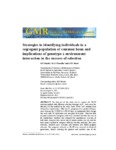Use este identificador para citar ou linkar para este item:
http://www.alice.cnptia.embrapa.br/alice/handle/doc/933542| Título: | Strategies in identifying individuals in a segregant population of common bean and implications of genotype x environment interaction in the success of selection. |
| Autoria: | MENDES, M. P.  RAMALHO, M. A. P.   ABREU, A. de F. B.   |
| Afiliação: | M. P. MENDES, ESALQ; MAGNO ANTONIO PATTO RAMALHO, UFLA; ANGELA DE FATIMA BARBOSA ABREU, CNPAF. |
| Ano de publicação: | 2012 |
| Referência: | Genetics and Molecular Research, v. 11, n. 2, p. 872-880, 2012. |
| Conteúdo: | The objective of this study was to compare the BLUP selection method with different selection strategies in F2:4 and assess the efficiency of this method on the early choice of the best common bean (Phaseolus vulgaris) lines. Fifty-one F2:4 progenies were produced from a cross between the CVIII8511 x RP-26 lines. A randomized block design was used with 20 replications and one-plant field plots. Character data on plant architecture and grain yield were obtained and then the sum of the standardized variables was estimated for simultaneous selection of both traits. Analysis was carried out by mixed models (BLUP) and the least squares method to compare different selection strategies, like mass selection, stratified mass selection and between and within progeny selection. The progenies selected by BLUP were assessed in advanced generations, always selecting the greatest and smallest sum of the standardized variables. Analyses by the least squares method and BLUP procedure ranked the progenies in the same way. The coincidence of the individuals identified by BLUP and between and within progeny selection was high and of the greatest magnitude when BLUP was compared with mass selection. Although BLUP is the best estimator of genotypic value, its efficiency in the response to long term selection is not different from any of the other methods, because it is also unable to predict the future effect of the progenies x environments interaction. It was inferred that selection success will always depend on the most accurate possible progeny assessment and using alternatives to reduce the progenies x environments interaction effect. |
| Thesagro: | Feijão Phaseolus vulgaris Melhoramento genético vegetal Seleção genética |
| Tipo do material: | Artigo de periódico |
| Acesso: | openAccess |
| Aparece nas coleções: | Artigo em periódico indexado (CNPAF)  |
Arquivos associados a este item:
| Arquivo | Descrição | Tamanho | Formato | |
|---|---|---|---|---|
| v11n2p872880.pdf | 397.1 kB | Adobe PDF |  Visualizar/Abrir |









